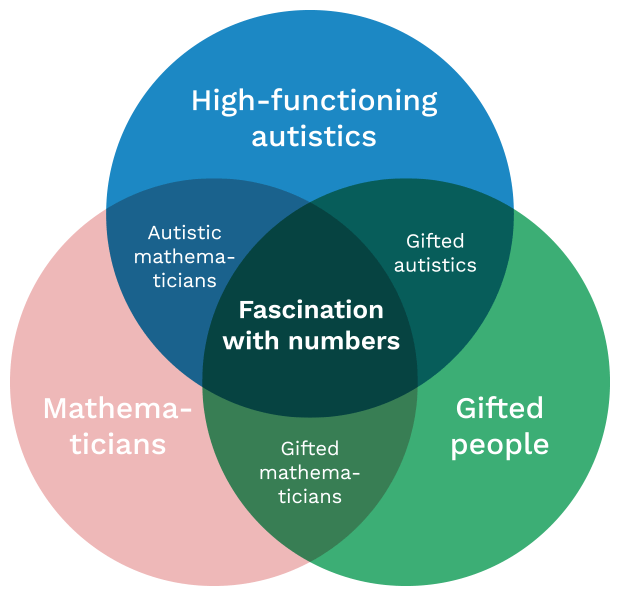While some autistic people have an intellectual disability (ID)[1]Link between autism genes and higher intelligence | The University of Edinburgh), most autistic people have average to above-average intelligence, but often demonstrate a significant unevenness in abilities; while we have our challenges, and there are things we aren’t as good as, autistic people typically excel in verbal tasks, as well as memory tasks (tasks that rely heavily on memory).[2]Misdiagnosis and Dual Diagnoses of Gifted Children and Adults: ADHD, Bipolar, OCD, Asperger’s, Depression, and Other Disorders | James T. Webb, Edward R. Amend, Nadia E. Webb
Disorder of high intelligence
Some autistic people score very high on intelligence tests, and a greater prevalence of people with IQs over 140 (gifted/genius level) has been found among autistic people.[3]Misdiagnosis and Dual Diagnoses of Gifted Children and Adults: ADHD, Bipolar, OCD, Asperger’s, Depression, and Other Disorders | James T. Webb, Edward R. Amend, Nadia E. Webb In fact, a link has been found between autism, high intelligence,[4]Common polygenic risk for autism spectrum disorder (ASD) is associated with cognitive ability in the general population (Clarke et al., 2016) and giftedness.[5]What Genius and Autism Have in Common | Healthland Consequently, some came to call autism a “disorder of high intelligence”. Estimated rates of intellectual giftedness in autistic children are 0.7–2%, compared to up to 1% in the general public.
Twice-exceptional
Intellectually gifted people who have some other diagnosable condition—such as autism—are called twice-exceptional.[6]The Six Types of Gifted Child: The Twice-exceptional | Jade Ann Rivera[7]A Unique Challenge: Sorting Out the Differences between Giftedness and Asperger’s Disorder (Amend et al., 2009) Gifted autistic children may not be identified as being autistic because their traits may be inaccurately assigned to their giftedness or to a learning disability.
Seven traits common to both autistic children without ID and gifted children:[8]Link between autism genes and higher intelligence | The University of Edinburgh
- Verbal fluency or precocity.
- Excellent memory.
- Absorbing interest in a niche topic, and may acquire significant factual information about it.
- Hypersensitivity to sensory stimuli is common in both groups of children.
- May frustrate peers with their limitless talk about their passionate interests.
- Fascination with letters or numbers, and enjoys memorizing factual information at an early age.
- May ask endless questions or give such extensive, specific responses to questions that it seems they are unable to stop.

Gifted individuals who were (likely) autistic:
Thomas Jefferson, Orson Welles, Wolfgang Mozart, Paul Dirac,[9]Paul Dirac & Henry Cavendish “How Autism Leads To Genius” | Aspie Editorial Albert Einstein, Isaac Newton,[10]Einstein and Newton showed signs of autism | NewScientist Carl Sagan, Glenn Gould, Henry Cavendish, and Ludwig Wittgenstein.[11]The World as Wittgenstein Found It | Autistic Symphony[12]The Different Thinking Styles of People With Autism | Evenbreak
Also have a look at:
Giftedness/Asperger’s Disorder Checklist
Read more:
Comments
Let us know what you think!